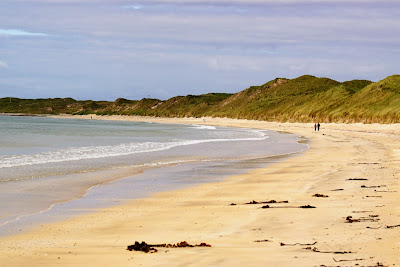 |
| Eilean Mor - ruins of the great hall |
All right, the history of the isles is less transparent than is suggested by the Finlaggan visitor centre and a great deal less clear than was described by Scots novelist Nigel Tranter in his justly celebrated Bruce trilogy.
Nevertheless, there are reasonable grounds for believing that the figure of Angus Og MacDonald bestrides the pages of Scottish history like a Colossus as the 13th-century gives way to the 14th.
A consummate politician, Angus Og nominally supported the English king Edward I as long as it allowed him an excuse to make war on the rival Clan MacDougall, but after the deposition of John Balliol and the murder of the Red Comyn, when the nominal King Robert Bruce was hunted like an outlaw through the western highlands by Lame John MacDougall of Lorne, The MacDonald seems to have changed sides.
 |
| causeway to Eilean Mor |
It is thought, but not absolutely certain that Angus sheltered Bruce at Finlaggan, which was more of a ceremonial centre for the clan than a fortress. There were neighbouring MacDonald castles on Islay that might have served better for defensive purposes. However, standing on the grass of Eilean Mòr, somehow aware of the ghostly presence of a man who scarcely acknowledged the overlordship of any ruler, Scots or English, you feel the two of them were probably both here back then.
Angus Og’s clan of Viking descendants had thrown off the Norwegian yoke and saw no reason to subject themselves to another – and anyone who thought differently was welcome to try sailing his own ships past the Corryvreckan whirlpool to challenge the best galley fleet in the British Isles!
 |
| Eilean na Comhairle (council isle), from Eilean Mor |
Though Angus Og seems to have waited for confirmation that Bruce could establish himself again on the latter’s return to Scotland, once his man was clearly king again, it was clearly in The MacDonald’s interest to have the mainland divided between Scots and English rather than allow an English hegemony which could threaten the Isles. I think the presence of the Islemen may very well have been decisive for the under-strength Scottish army at Bannockburn, however bad the generalship of Edward II may have been.
It does appear the Bruce thought so too, for Angus Og was well rewarded for his help. It appears he may also have supported Edward Bruce’s ill-fated Irish expedition, and may even have died there. All we know for sure is, he was no longer the Clan Chief in 1330 and that his son John became the first to claim the title ‘Lord of the Isles’.



















